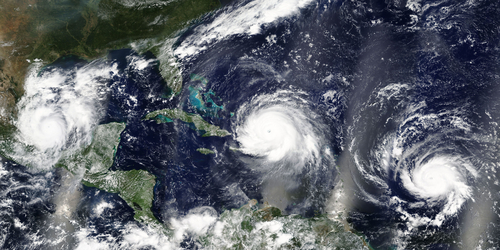
As devastating as hurricanes have ever been to coastal communities, the Pacific Northwest National Laboratory (PNNL) sounded the alarm through a new study this week, claiming that climate change will bring faster, wetter, stronger storms to come up and down the Atlantic Coast and beyond.
In a paper published in the journal of the American Geophysical Union, researchers found that the rates at which hurricanes strengthen near the U.S. Atlantic Coast have risen since 1979, and the trend is likely to continue. The problem is that climate change has brought a host of environmental conditions favorable to the storms. While the Gulf of Mexico lacks the same hurricane favorability at this juncture, areas such as the East Asian coastline and the northwest Arabian Sea are also becoming increasingly favorable as storm breeding grounds.
“Our findings have profound implications for coastal residents, decision- and policy-makers,” Karthik Balaguru, PNNL climate scientist, said. “And this isn’t specific only to the Atlantic. It’s happening in several prominent coastal regions across the world.”
As global temperatures rise, so too does the Earth’s surface. When greenhouse gasses simultaneously build, study co-author Ruby Leung pointed out, the temperature difference between warmer land and cooler seas grows increasingly divergent. Over the warmer land, the air pressure is lower, while over the cooler sea, it’s somewhat higher. Consequently, the higher pressure air blows inland, which Earth’s rotation winds into a twist of air that pulls humid air up into the atmosphere, converting all that heat and moisture into damaging winds.
Add more gasses for warmth, and the twisting motion only strengthens, emboldened by the humidity of warmer sea surfaces, the researchers found. Traditionally, dry, vertical wind could counter this, but that phenomenon has weakened over the past 40 years, at least on the Atlantic Coast.
“Unlike the ocean with unlimited water supply, there’s much less water in soil,” Leung said. “That means the land can’t evaporate as much water, so it can’t get rid of the extra heat trapped by greenhouse gasses as quickly as the ocean. Indeed, global maps depicting past and future warming show the distinct pattern of land warming more than the sea. This increasingly strong difference can create stronger storms.”
According to the team’s models, wind shear will – if the world continues its use of fossil fuels at the core of its economy – weaken further along the Atlantic Coast, while the maximum intensity storms can sustain under prevailing conditions will increase. Atmospheric humidity and nearshore vorticity will rise, too, and and-sea temperature differences could arise in other coastal areas, leading to wetter, faster-developing storms across the board through 2100.
Or at least, this will be the case for the northern hemisphere. The team focused there, though Balaguru noted that one could expect the same thing to happen on coastlines of the southern hemisphere as well.
The effects could be felt even further still – with implications for human populations worldwide, the researchers concluded.




